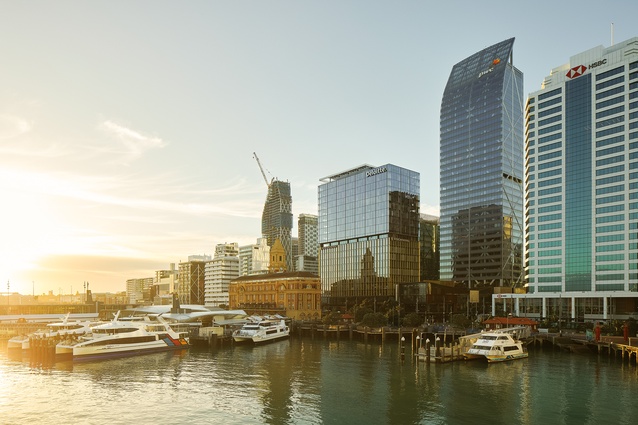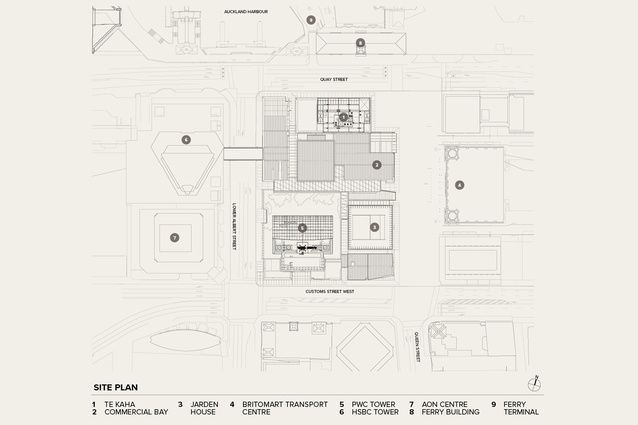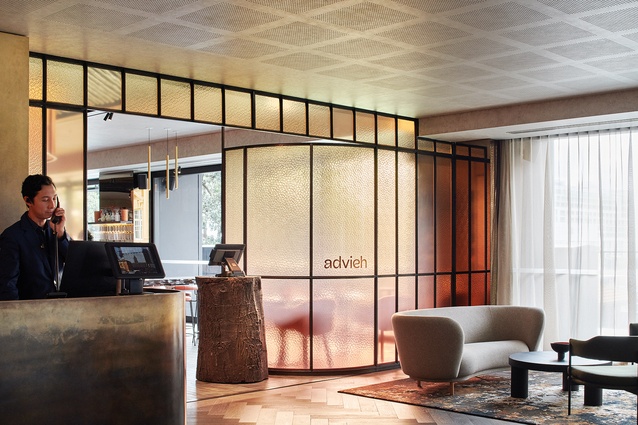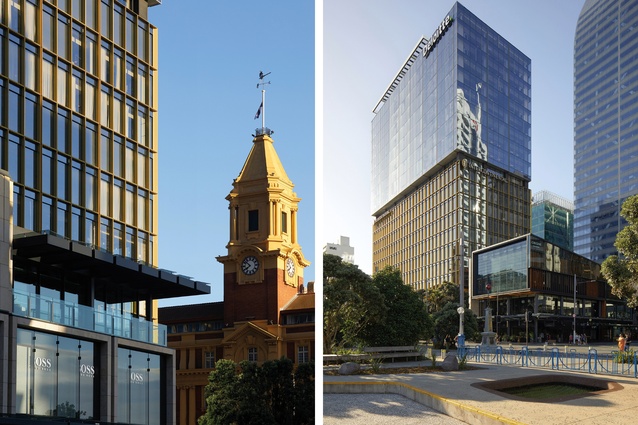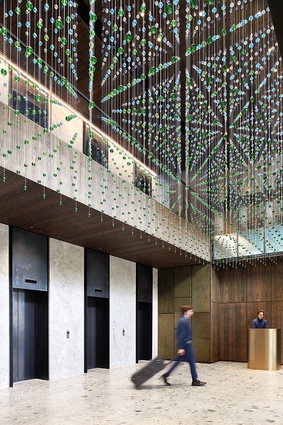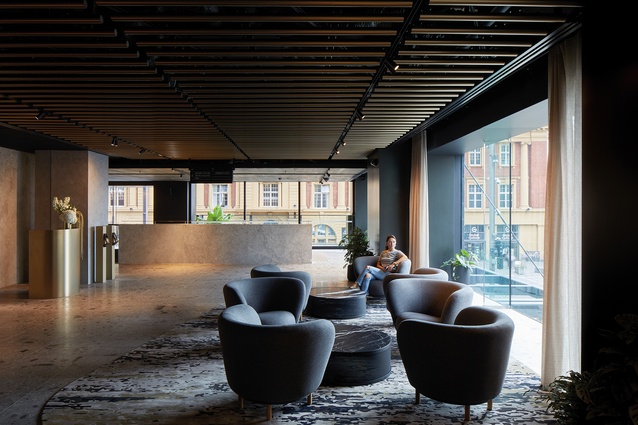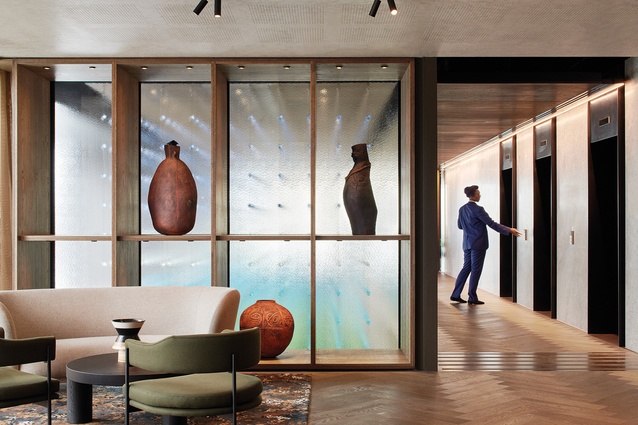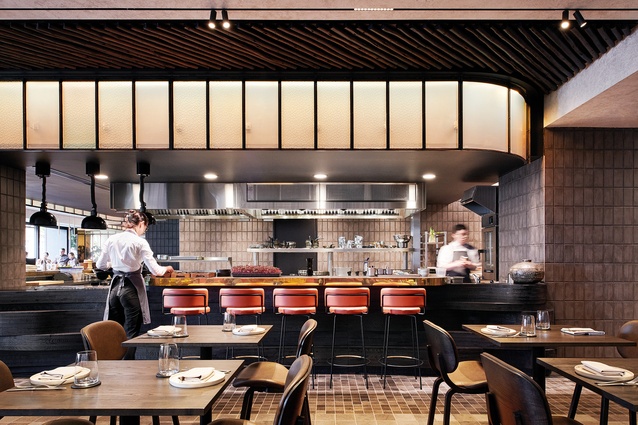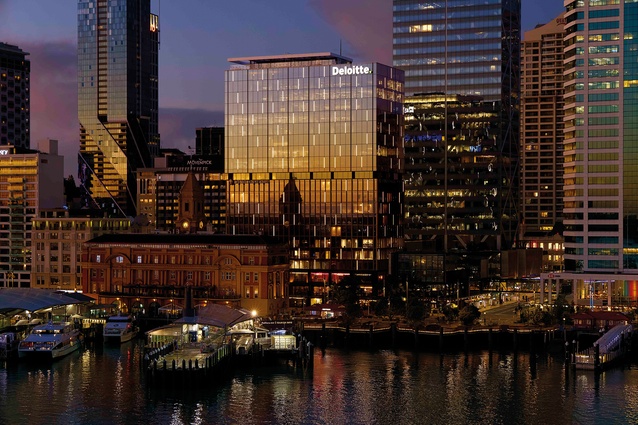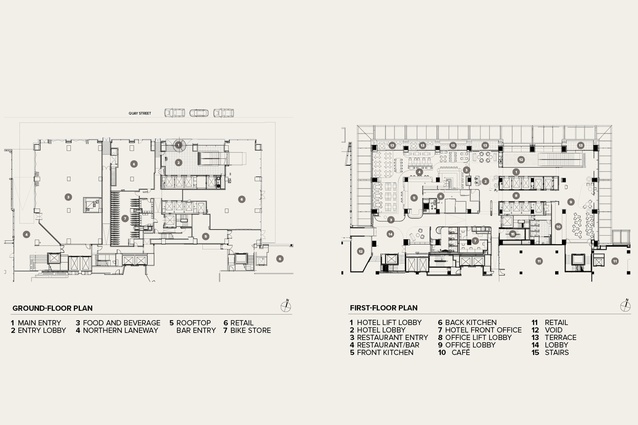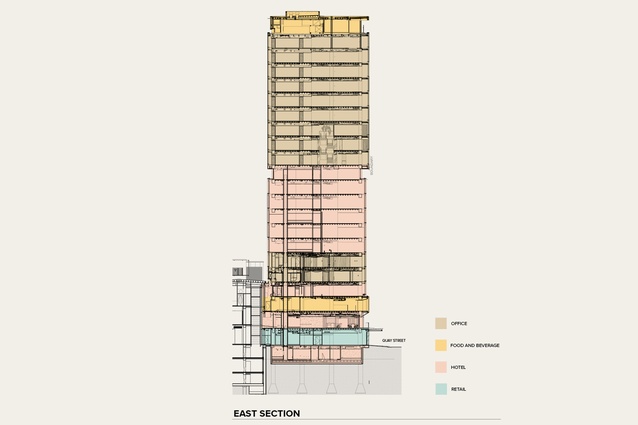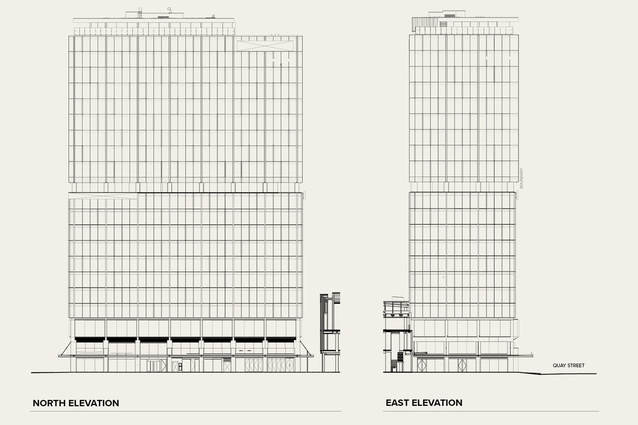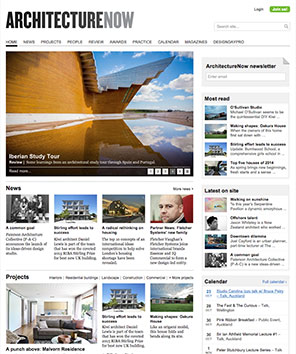What’s in a name?
Bill McKay looks at Warren and Mahoney’s transformation of the 1970s’ Office Block 1 on Auckland’s waterfront — fomerly Air New Zealand House — into Te Kaha – Deloitte Centre, a vibrant, mixed-use tower combining hotel, offices and retail.
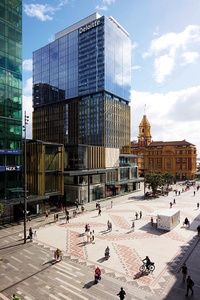
A generation (or two!) won’t know this building as the old Air New Zealand tower of the 1970s. It was originally part of a modernist comprehensive development at the end of Queen Street where city meets sea, seen as a key site for some city-directed place-making. Evolving plans saw a shuffling around of typically modernist urban elements, such as low-rise tower, broad central mall, open plaza and high-rise ‘vertical feature’ tower. This high-rise was ominously labelled in Orwellian-speak as ‘Office Block 1’ and it ended up in the worst possible place on the site. Public scrutiny, led by Auckland’s Architectural Association, saw air tunnel testing of the design, thought to have been a first in the country, not that it had much effect on official thinking.
Office Block 1, located to the north of the plaza with sun shading and wind effects, has blighted the area ever since. Downtown, as the rest of the development became known, ended up as a dour example of exhausted 60s-style, end-of-era brutalism: a stubby office tower to the south, a squat, mud-coloured shopping centre entombed in concrete, and a plaza soured by cold southerlies rather than warmed by Pacific breeze. The plaza was graced with the name Queen Elizabeth Square, not that it helped, and Office Block 1 became Air New Zealand House, the design of which had all the grace and flair of a (then) state-owned airline. You can still see postcards online of the Square and the tower looking like some bleak industrial estate outside London.

Why this much backstory? It is important to establish physical and historical context, especially when the architectural project under review is, increasingly, the opposite of post-war-style comprehensive development when everything was swept away and the architect started from scratch. Yes, developer Precinct Properties, with Warren and Mahoney also as architect, has swept away the old Downtown development and replaced it with Commercial Bay: shops, food, hospitality and an enormous office tower more sensibly located to the south of the site.
But the tower we are looking at here takes a more contemporary approach. In our time of urgency, responding to climate change and with a sustainability imperative, architects are increasingly dealing with existing buildings on a spectrum from tweak/tune to completely gutting and stripping back to skeleton. This 21-storey building is at the latter end of the adaptive re-use spectrum, mainly because it has become a much more mixed-use building than was the old monolithic office structure. This has required great changes, such as removal of pre-cast concrete cladding (which always helps seismically), removal and replacement of services, new bolt-on floor extensions, a new high-performance glazed façade, a few walls punctured to integrate with Commercial Bay’s shops and hospo options, and a rooftop terrace added.
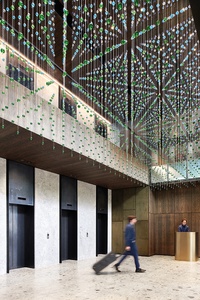
What’s in a name? From Office Block 1 to Air New Zealand House then through a few naming-rights monikers, 1 Queen Street has been gifted the name Te Kaha by Ngāti Whātua Ōrākei. Now, it is also the Deloitte Centre (name at the top of the tower) and InterContinental on the base and also halfway up. Externally, to express all these different aspects, the tower’s façade is split in half with two different treatments: one for the hotel that occupies the bottom half, another for the office floors above, separated by a recessed waist in the torso. The hotel levels have been extended by 800mm bolt-on floor-plate cantilevers and the glazing has very pronounced gold-ish mullions, which convey a sense of quality and individuality, suiting a five-star operation such as the InterContinental. They also look delicious when contrasted with the big blue sky and the sparkling Waitematā reflected in the glass, and are a nice contrast to the interior public spaces’ more broody, volcanic colours. The upper office half of the tower has a slicker and more homogenous façade treatment. These levels also project more: 1500mm to the north.
The ground level has a variety of retail/hospitality spaces and the core plans are quite fascinating, looking at circulation. Adaptive re-use is all very well in principle, and sounds simple, but vertical systems can be quite a different story, serving quite different needs at different levels and at different times of day. Lifts in your generic, more straitjacketed office building are simple in principle, often an excruciatingly awkward hiatus in human interaction. No wonder they have become quite a trope in numerous fictions and films, from action movies, through horrors, dramas and satires, to comedies and romances. There is an article in this alone, memo to editor. But, meanwhile, back in real life, conversion of functionally simple buildings to mixed use can be a big issue; lift shafts can be too small, too few, too big or in the wrong places, serving too few floors or too many. Luckily, modern technology and little computerised brains can help. I’m going to make these floor plans required reading for students studying multi-storey building services.
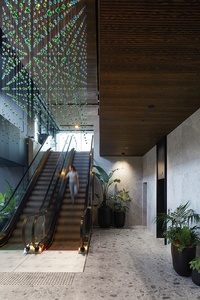
The Quay Street entry to the upper levels is via a lobby with a concierge to point you the right way but, as we find increasingly in large complex buildings, the real arrival point is a floor up above street level, on a kind of piano nobile (the principal floor of your palazzo). The escalator ride up here is made spectacular (much more exciting than a lift!) through the marvellous artwork of Australian artist Nike Savvas. Essentially, it is your childhood bunch of marbles woven into a suspended, sophisticated constellation. Like a tukutuku transformed into more dimensions, with more physical depth, it literally opens up new perspectives as you look through its starry sky to the world outside. Interactive is the buzzword these days but I prefer experiential. This building has many artworks, mostly by artists affiliated with Tāmaki Makaurau iwi and unified by the concept of aukaha (primarily developed with Ngāti Whātua Ōrākei): the bindings that lash a waka together. The building’s façade also incorporates lighting elements that can be programmed into different sequences. We’ve seen two: at Matariki and as part of Auckland’s recent Art Week by artist Pāora Puru (Ngāti Te Ata Waiohua, Waikato, Ngāti Ranginui and Ngāti Rangitihi). I love the way cities today are shifting from the sad old overcast pall of sodium street lights hopelessly trying to simulate daylight, to a more subtle (and energy-efficient) variety of lighting experiences that can make our evening excursions feel more theatrical, more special.
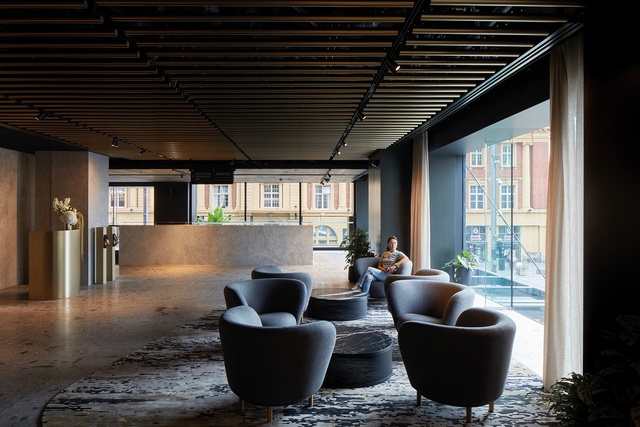
The first floor, the piano nobile, was a former carparking level. Now, it is a Gordian Knot of connections: office lobby with meet/greet/seat space and café, hotel lobby, separate banks of lifts, restaurant, its kitchen, hotel offices, toilets, other service spaces, egress stairs plus three connections through the back wall into Commercial Bay’s shops and foody spots. I told you it was complicated!
Each hotel floor typically has more than 20 generously sized rooms while the office levels have options from boutique to big. It will also be possible to expand hotel floors upwards into the office floor plate should current trends continue, diminishing demand for office space. The office levels have areas where services are exposed, making the floor-to-ceiling appear more generous than it did back in the day of the gloomy suspended ceiling era.
And finally to the roof. All this building’s floors overlook the harbour but the roof is the best vantage point or, in a slip of the tongue in a Best Awards citation, ‘vintage point’. Well, the ground-floor entrance is via a wine shop. There are terraces on three sides and a large extent of green roof planted in native grasses. Back down the lift and disgorgement into the former Queen Elizabeth Square: now, in a goodbye to colonial kowtow, it is called Te Komititanga, a welcome return of a sense of Pacific and Māori presence. It is a shame that this corner where the tower meets Queen Street is still a shady, weather-exposed spot and a space that’s not-what-it-could- be. But that’s the story of Auckland and more the responsibility of Council than of the architects.
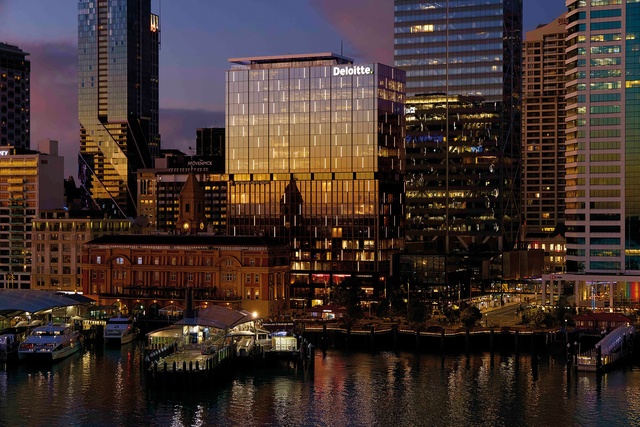
As Warren and Mahoney put it: “Our built environment has a demolition addiction.” This design goes beyond refurbishment to create new mixed-use spaces through adaptive re-use, reducing environmental impact along the way (targeting 6 Green Stars, 4 NABERSNZ). All this has been addressed without compromising building performance, design quality or innovation. It has inserted diversity into a monolith that won’t only suit today’s requirements but will be adaptive in the face of future needs. However, as architect Michael Mason says: “Everything in here needed a really creative solution.” As I increasingly wonder about the future of architecture in the face of city centre evolution, climate change and challenges to the profession such as AI, it’s good to know a team of good people can still come up with smart solutions.

